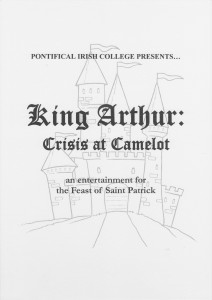
St Patrick’s Celebrations 2013 at the Irish College
All are welcome to the Irish College at 19.00 on Saturday 16th and Sunday 17th March 2013 for the staging of the comedy, ‘King Arthur: Crisis at Camelot’, adapted from a script by Geoff Bamber, directed by Conor McCarthy. This promises to be an evening of laughter and light-hearted enjoyment. There will be a collection on the occasion for this year’s College Lenten charity, the Sant’Egidio Community.
Please note that Mass for the Feast of Saint Patrick will be celebrated at 10.00 on St Patrick’s Day in St Patrick’s Church, Via Boncompagni 31, near Via Veneto. As the Mass in St Patrick’s Church will be the focal point for the Irish community in Rome and friends, there will be no Mass in the Irish College on that morning.



